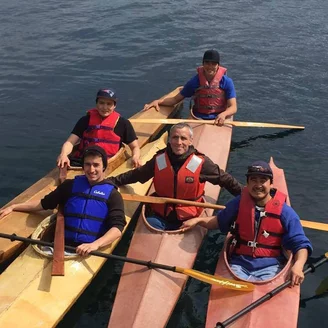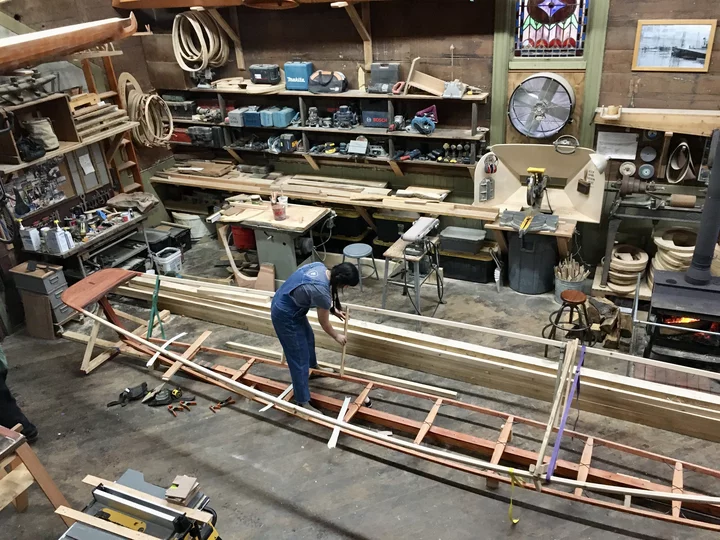Kanesia McGlashan-Price and Marc Daniels next to the nigilax̂ frame at Mind’s Eye | Photos by Stephanie McGeary, unless noted
###
For Marc Daniels-Aygagnax̂, owner of Mind’s Eye Manufactory & Coffee Lounge in Ferndale, building traditional Unangax̂ kayaks is not only a way to help preserve tribal history, but also to teach a craft and help build something that can be used by many people for many years.
“Our goal is to be relevant,” Daniels told the Outpost in a recent interview at Mind’s Eye. “We’re not making something to hang up in a museum, to stare at and wonder about some past thing. We’re trying to make it a living thing – not a relic.”
Daniels and a team of volunteers are currently building a nigilax̂ – a large, multi-person skin boat traditional to the Unangax̂ tribes of Unangam Tanangin (the Aleutian Islands), off the coast of Alaska – in the Mind’s Eye shop. The project is a part of Daniels’ nonprofit program, Make Access Iqyax̂ Apprenticeships, a DreamMaker Project of the Ink People that aims to preserve and bring awareness to Unangax̂ cultural heritage through building these traditional boats.
Daniels has been building kayaks for 30 years, teaching the craft at schools and tribal organizations around Alaska, the Aleutian Islands and Washington. Daniels moved to Humboldt from Bellingham, Wash. about 10 20 years ago when his father bought a property in Ferndale that Daniels was helping fix up. Daniels and his wife had a lifelong dream of opening a creative space where “minds can come together and where ideas and the disciplines of craft can cross pollinate,” he said. When they found a space available in downtown Ferndale, they decided to stay in the area, start their dream business and raise their two children here.
But Daniels still spends a great deal of time in Alaska, helping groups build nigilax̂, iqiax̂ (single kayaks) and ulux̂tax̂ (double kayaks) and taking them out on the water. With this specific project, Daniels and the team hope to bring some awareness to the Unangax̂ history in Northern California, something that is not widely known about.
In the 1700s and 1800s, Russia invaded the Aleutian Islands and enslaved many Unangan people, taking them away from their islands and forcing them to help with sea otter hunts along the coast between the U.S. and Canada. Many of these Unangan slaves ended up at Fort Ross – a Russian fur trading outpost located in what is now Sonoma County. Many of the Unangan people stayed in the area and intermarried with other native tribes and some Unangan descendants still live in Northern California today.
Like other Native tribes, Unangan people were forced to assimilate to white culture, convert to Christianity, and many of their own traditions were nearly lost. Daniels said he is happy to see a recent revival of cultural traditions among many native tribes.
“There’s a huge cultural revitalization movement,” Daniels said. “A lot of the young folks are embracing [the culture] and becoming leaders.”
Kanesia McGlashan-Price is an Unangan tribal member who grew up on Iliuliuk (Unalaska) – one of the Aleutian Islands. Having learned from Daniels during his visits to the islands, McGlashan-Price came down to Ferndale to work on this nigilax̂ build and to help document the process for the video she is making on the Unangax̂ cultural history. McGlashan-Price told the Outpost that she has always wanted to be a part of a build and she loves to see how this process is helping Unangan youth be more connected to their heritage.
“I like that this is becoming a regular practice and the fact that it’s something our youth are starting to grow up with,” McGlashan-Price said. “In the last 12 years, Marc has been coming to our Alaska culture camp and kids are starting to learn how to work on [the boats] from a young age. So I just love that it is common practice again.”
McGlashan-Price working on the boat
For this project, Daniels said it was very important for him to also connect with the local tribes, the Wiyot and Wailaki (Kun-nes-t’e) people of the Eel River Valley, to invite them to be a part of the project and to ask for their blessing for this project to take place on their land.
Marnie Atkins, cultural center manager for the Wiyot Tribe, told the Outpost that she was very happy to connect with Daniels on this project and that the tribe is looking forward to collaborating with Daniels on future projects. As coastal, seafaring tribes, Atkins said, the Unangax and Wiyot have a lot to share and learn from each other. The tribe also invited Daniels to join in a Wiyot canoe build – a process that is also very significant to the Wiyot Tribe as a way to preserve the tribe’s traditions and to build stronger community relationships.
“There are the mechanics of [building a boat] that are being passed on – what wood you choose, why you choose that piece of wood, how you make it into a boat…how you clean it,” Atkins said in an interview at the Wiyot Cultural Center. “But along with that, there’s building a relationship with that canoe or kayak. And through building a relationship with what you’re creating, you’re building relationships with the other folks who are creating it with you. And that also deepens those relationships and those traditions and those protocols that you have. That’s all very important.”
Building a nigilax̂ is an involved process that usually takes between a month and a month and a half. The volunteers began by combing the local beaches for driftwood and downed trees. The boat is made entirely of found, native wood – a combination of Sitka spruce, cypress, Douglas fir and redwood. Daniels said that this process is used, instead of buying lumber, because it is more traditional and also because the type of wood they look for is not always very available for purchase. The Sitka spruce, in particular, is very special because it is strong, but also light and springy.
After the wood is cut and sanded, the frame is built and “ribs” are placed throughout the vessel and are lashed into place with cord. The floorboards and seats are then added and secured. After everything is in place, the vessel is covered with a heavy nylon fabric that is then shrunk around the frame, then dyed and coated with sealant. Traditionally, the boats would have been covered with sea lion skin.
When this nigilax̂ is finished, Daniels said, it will be taken down to Metini (the Unangax̂ name for the area known as Fort Ross) for an official launch as a part of Native Alaska Day – a celebration that takes place on the third Saturday in May. The boat will also be used monthly for environmental education outings on Humboldt Bay and other local waterways. Daniels said that the nonprofit is still figuring out the details for this component of the project. The vessel will also be available for Unangax̂ tribal members to take to gatherings, like the tribal canoe journeys that happen in Washington.
If you are interested in learning more about the nigilax̂ building process and seeing the impressive vessel for yourself, the builders are holding an open house event at Mind’s Eye Manufactory in Ferndale on Saturday, March 11 from 1 to 8 p.m. The free event will feature a hands-on workshop, guest speakers, food and music.
“These inventions are really sophisticated,” Daniels said. “They’re not just a bunch of sticks pulled together. Even from a hydrodynamic, modern view of them – scientists and physicists marvel at how perfect they are. So, to me, by making [these boats] relevant and real again, that mindset can live again.”
###
CORRECTION: This article previously misstated that Daniels is of Unangax̂ descent. It also incorrectly referred to the nigilax̂ as a type of kayak. The article has been changed from its original version to correct those errors.
The build team, from left: Christopher Grimes, Scotty Colin, Marc Daniels, Kanesia McGlashan-Price and Mike Ferguson





CLICK TO MANAGE